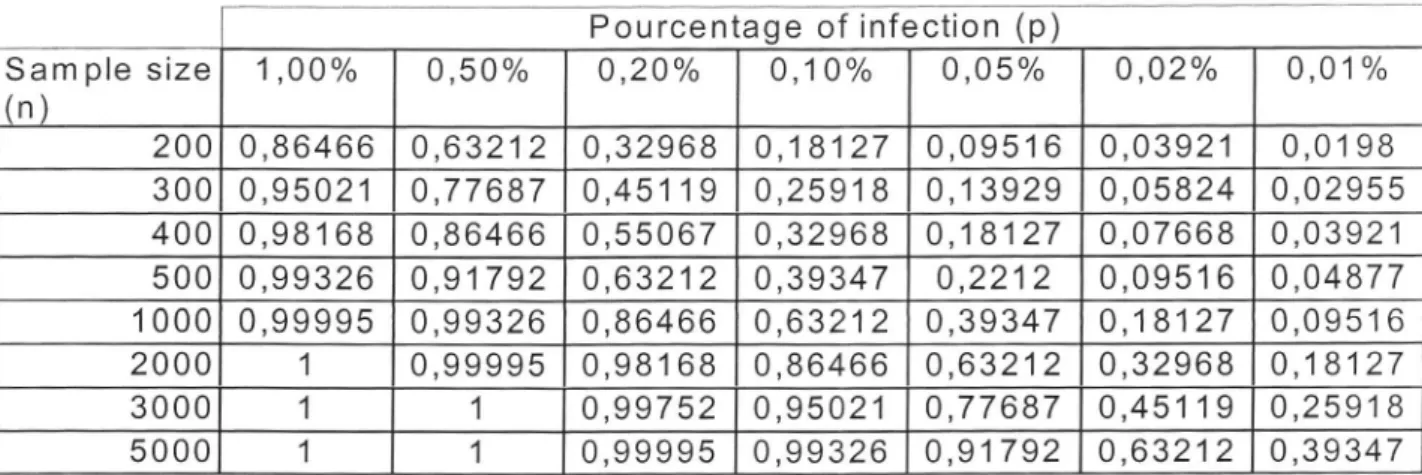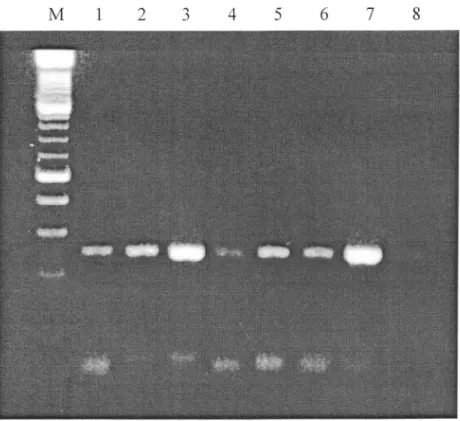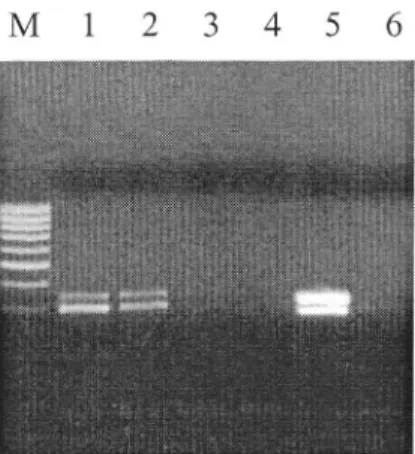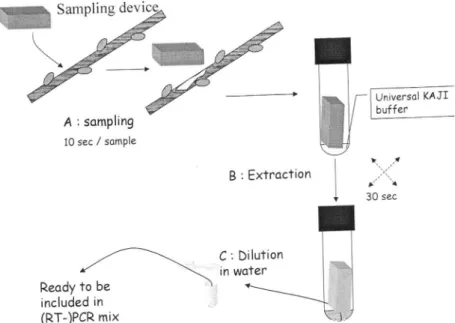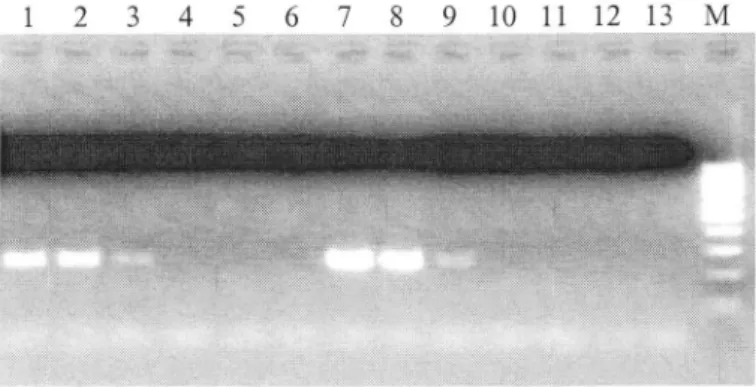Statistically
reliable sampling
and
diagnosis of
plant
pathogens using
a
simplified
"universal"
protocol
for
sample preparation
and
analysis
by
(RT-)PCR
O. Dutrecq, P. Lepoivre, S. Roussel, J. Kummert, M.H. Jijakli Plant Pathologv unit'
o"*oliîâ'.ffiï'JTli!"Ëffi:*'
Passage des Déportés' 2'E-mail : dutrecq.o@fsagx.ac.be; Tel : +32 81 62 24 31 ; Fax : +32 81 61 01 26
Summary
Thanks to the higher sensitivity of molecular tests based on PCR techniques, researches
have been conducted
to
showthat
processingof
pooled
samplesis
realistic
and canbring a positive
solution
to
sanitarycontrol
proceduresby
increasingthe
statisticalreliability of
the obtained results. Rateof
pooling
dependson
sample type, batch size, required sensitivity, and expected and accepted levelof
infection.But
the useof
pooled samplesalways allows
to
test an
increased numberof
sampleswithout
dramatically increasing the cost.In
parallel
anew simplified
"universal"protocol
has been developed and patentedfor
sampling and sample preparation. This
protocol
allowsfield
sampling either on woodyor
herbaceousplant
tissues, easy conservation and transportto
laboratory where a few seconds are requiredfor
sample preparation beforeits
inclusionin
PCRmix.
The sameprotocol
canbe
appliedon different plant
speciesfor
detectionof
different
pathogens(virus,
viroïds,
phytoplasms,
bacteria,
fungi,...)
and
is
especially
dedicated
to laboratoriesthat do not want
to
invest
in
an
expensiveroutjne
sample preparation device.Introduction
Until
now,validation
of official
methodsof
analysisfor
phytosanitarycertification
hasbeen
exclusively
based
on the
technique
itself
(sensitivity,
specificity,reproducibility,...). The definition
of
sampling protocols
was most
generally
not integratedin
thevalidation
step dueto incompatibility
between statistical requirements andworkability.
Treatmentof
large numberof
samples arisesdifferent
problems suchas increasing
of
the costof
analysis and complicating handling, storage and elimination of the processed samples.This
paper
presentsthe
approachfollowed
by
the
Plant
Pathology
Unit
of
theAgricultural University
of
Gembloux during
the
last
decadefor
the
developmentof
"user
friendly"
diagnostic techniques based on PCR. These works have been conducted on different plant materials and pathogens(mainly
Latent andILAR
viruses on Prunusand
Malus
fruit
trees, Potatovirus
Y,
X
and S and Ralstonia solanacearum on potato)"Simplification
of
the PCR techniqueis
essential andis
amajor aim
of
the
laboratoryRapid
overview
of
sfafistical
requiremenfs for sampling
W'hatever
the
diagnostic techniquemay be,
statisticalvalidation
of
the
procedureof
analysis is a test
of
hypothesis wheretwo
different risksof
error are assessed:(i)
a false positiverisk
(producerrisk)
if
a non infected sampleis
declared infected after analysis and(ii)
a
false
negativerisk
(consumerrisk)
if
an infected
sampleis
not
detected.Numerous
factors
influence
those
risks
among
which
sensitivity,
specificity,reproducibility,
accuracy,
...that
can
be
considered
as intrinsic
properties
of
the techniqueof
analysis.This
paperwill
focus
on the most
important external
factor influencing the consumer risk: the sampling.Numbers
of
phytosanitary
crisis
have
arisen becauseone
or
severalfalse
negative results have occuned at one step of the certification procedure.The consumer
risk
could be considered as the most importantin
certification because,if
it
occurs,it
canrapidly
conductto
a crisisin
which
the producerhimself
supports thenegative
effects. Moreover, when positive results arise, confirmation
analysis
is generally performedfor confirming or
infirming
false positive hypothesis. 'Whereas, no confirmation of negative results is performed asit
is considered as the normal case.A
statistical approachis
essentialin
phytosanitarycertification
scheme wherelow
tovery
low
infection
rates are generally metin
nuclear stocks and nurseries. Detectionof
one infected
individual
among thousandsof
non infected ones requiresto
pick
up thisindividual
during sampling otherwise a false negative resultwill
be produced.To secure consumer
risk
it
is necessary to determine theminimum
numberof
samples to be takenin
function of the pathogen/host pair considered.Works have previously been conducted (Chandelier et a1.,2001) that analyze consumer
risk for
distribution
of PVY
infection
in
potato tubersin
the
field.
This
risk
has beenrelated
to
binomial distribution. Table 1,
representingthe binomial distribution
of
consumer risk, gives the number of tubers that should be sampled and analyzed to detect
(with
various ratesof
confidence) an infectedlot for
variousinfection
levels. Recent studies performed on apple trees infected byASPV
andACLSV
(Kummert et a1.,2003) show that, especiallyin
caseof
heterogeneous infection byACLSV, it
can be necessary to testuntil
8 leavesfor
each tree to detect the viruswith
a confidenceof
99.9 %. In this respect, valuesin
Table
1 should bemultiply by
8 for
reliablemonitoring
of fruit
treemultiplication material. Those results consider
that
each
sample
is
analyzedindividually.
Pooled sampling can therefore bring a solution
by
analyzing several individuals together as a unique sample. The consumerrisk is
similar
whenindividual or
pooled sampling are presentedfor
analysis whateverthe
rateof
pooling
applied.But
pooled
sampling affordto
test larger numberof
individuals keeping constant the numberof
analysis and therefore reducing the unitary cost of a diagnostic test.Where
molecular fesfs
can
bring answer
to
statistical
requirements.
..
Sample
pooling
Testing
of
pooled samples requires to use techniqueswith
high
sensitivityto
detect one infected plantamongl0,20
or even 100 non infected ones when analyzed together.RT-PCR tests
developed
at
Plant
Pathology
Unit
of
the
Agricultural University
of
Gembloux
on
crude extractof
different plant
material (potato tubers and leaves,fruit
tree
twigs
and leaves) have shown thepossibility to
reachhigh pooling
rates.Figure
1shows the results obtained by
pooling
20, 40 and 80twigs
of
apple tree togetherfor
the detectionof
ASPV
wherethe
specific bandis
clearly
observableon the
agarose gel.Worst
caseis
presented whereonly
1 infectedtwig
is mixed
with
respectively19,39
and 79
non
infected ones.Pooling
of
150twigs (1
infected+
I49
non
infected) have also been successfully conducted to detect PNRSV in Prunus (data not shown).Multiplex analysis
Pooling
of
samples brings undeniable advantagesto
reduce the numberof
analysisfor
detecting one pathogen in plant material. When two or more pathogens have to be tested
in
the
same sample,multiplex
analysis can alsooffer a
good solution
to
reduce thenumber
of
tests
to
be
performed. Therefore single RT-PCR
techniqueshave
been improvedto allow Duplex
analysisfor fruit
tree viruses(ASPv-ASGv; ACLSv-ApMv,
PDv-PNRSv). The Duplex
PDV-PNRSV
(Figure 2) was equally sensitive as the singletest reaching
dilution
106for
both
single (data
not
shown) and
duplex
runs.
It
is therefore reasonableto think
that a combinationof pooling
and duplex can be useful to be integratedin
acertification
procedureby
increasing numberof
samplesto
be testedwithout
increasing the cost.However,
in
this
approach theonly
cost reduction consideredis
directly
relatedto
the analysisitself
once samples are ready to be includedin
the analytical run. Costs related to sample preparation are not considered at this step but arestill
an important bottleneck for large number sample preparations.Si
mpl
ification
of sample
preparation
Beside the cost
of
PCR reagents, sample preparationis
oneof
the major bottleneckfor
applicability
of
PCR
techniquein
routine
analysisat a
competitive
price
especiallywhen
nucleic acid
extraction and
purification
is
necessary.In
those
cases, sample preparationcan
be time
andworkforce
consuming.For
a
couple
of
years, differentprotocols
have been proposedto
work
with
crudeplant
extractsto
simplify
sample preparation. However,inhibitory
effects on PCR appeared, caused by plant components or by oxidizatton of plant extracts.These problems are particularly met when processing
of
woody plant tissues and occurTherefore a specific protocol was
initially
set upfor
sampling and preparationof
woody tissues for the detection ofILAR
and Latentfruit
tree viruses. Figure 3 shows resultsfor
comparison
of
detection sensitivity of ASPVfollowing two
different protocols for crude extract preparationfrom
appletwigs. The
classicalprotocol
follows
Kummert et
al., 2001with
Homex grinder and the second one is the new patented protocol presentedin
Figure 4. Similar maximum
dilution
was reached for both protocols.This
newprotocol
hasrapidly
shownits
"universal"
application whateverthe type
of
plant material
(fruit
trees, banana trees, Potatoes, Tomatoes, Sweet Potato, Tobacco, Catharantus,...)
or
tissue (leaves, stems,woody
tissues, tubers)or
pathogen (viruses, phytoplasm,viroïd,
fungi, bacteria).This original simplified
protocol (Figure
4)
is
basedon a
samplingdevice
plus
the"universal"
KAJI
extraction buffer especially developed for that protocol.If
necessary,the
sampling device can easily be usedin
field. Only
few milligrams
of
infected
plant
tissues are sampled and canbe
storedduring
at
least3
weeks at room temperature. Thanksto
this
device,
sampled tissuescan easily
be
sentby
standardcourier
to
the
laboratory
for
analysis.Before inclusion
in
(RT-)PCR
Mix,
sampled tissues are placedin
a
10ml
tubewith
1,5ml
of
the extractionKAJI
buffer,
vigorously agitated during 30 seconds.Clarified
crude extract can easily be directly pipetted outof
the tube and diluted
in
distilled water according specifications for plant and tissue type.This
diluted
extractis
readyto
be included
in
the (RT-)PCR
mix.
A
wide
rangeof
various pathogens can be tested from the same extract.
If
necessary (e.a. for research purposes) a Total NucleicAcid
extraction andpurification
protocol has been adapted for application after crude extract has been prepared.The advantages
ofthis
new protocol are:-
its universality
(different
tissues,different
plants,different
pathogens) which greatly simplifies lab management especiallywithin
quality control procedure.-
its
easinessof
use(parlicularly
for diffrcult
samples aswoody
tissues), whichreduces
time
consuming steps,limits
manipulation mistakes, facilitates transport and storage of the samples and does not requires any specific grinding devices.-
Its high trough
put
capacity. Hundredsof
samplescould
be processedin
thesame
time without
expensive automation.As
tissue sampling candirectly
be performedon the
field,
lab is not
overcrowdedwith
plant
material. Moreover, this protocol isfully
compatiblewith
Pooled sampling and Duplex analysis.-
Itsreliability
This
universal
protocol
has been recently
patentedand
is
on the way
for
official
Conclusions
Thanks to the development
of
a"universal" simplified protocol
for
sample preparation, processing of numerous plant samplesof
any type is possible. This protocol allied to the powerof (RT)PCR
techniquesfor
treatmentof
pooled samples andmultiplex
analysisoffers new
perspectivesfor
phytosanitarycertification: statistically reliable
sampling becomes realistic and economically workable.Pourcentage of infection
(p)
Sam
ple size
(n)
1.00o/o 0,50vo 0,200/o
0,10%
0,05%
0,02%
0,010/o200 0,86466
0,63212
0,32968
0,18127
0,0951
60,03921
0,0198
300 0,95021
0,77687
0,45119
0,25918
0,13929
0,05824
0,02955
400
0,981 6g0,86466
0,55067
0,32968
0,18127
0,07668
0,03921
500
0,99326
Q,91792
0,63212
0,39347
0,2212
0,09516
0,04877
1000
0,99995
0,99326
0,86466
0,63212
0,39347
o,18127
0,09516
2000
10,99995
0,98168
0,86466
0,63212
0,32968
0,18127
3000
1 1 0,997 520,95021
0,77687
0,45119
0,25918
5000
1 10,99995
0,99326
0,s1792
0,63212
0,39347
Table 1 : Probability
of
detection of an infection in an infinite population for various levels of infectionFigure
l:
RT-PCR Detection of ASPV in crude extract prepared fromapple twigs following the "universal" patented protocol. Lane l, Lane 2 and Lane3: dilutions of 1 infected twig respectively in 79,39 and 19
healthy ones before extraction. Lane 4, Lane 5 and Lane 6.: Dilutions of
1 part ofinfected crude extract respectively in79,39 and 19 parts of
healthy one. Lane 7: Infected crude extract non diluted. Lane 8: Negative control.
Figure 2: Detection of PDV-PNRSV in crude extract from Prunus twigs and revelation
on
2Yo agarose gel after duplex RT-PCR.Lane 1, Lane 2,Lane3,
Lane4:
dilutionsof
respectively 105, 106, 107 and 108 times of crude extraçtin
sterile water. Lane 5: dilution 102 as positive control. Lane 6: negative control.Crude
extracts
were
prepared foolowingthe
"universal" patentedB:
Extroction
I
\. ...t ,i: tt 30 sec Reody to be included in (RT-)PCR mixFigure
4:
Descriptionof
the
sampling and sample preparationp.8""a*"
with the iatented "tmiversal" protocol'M
13
t2
Figure 3: Detection of ASPV in 2 crude extracts (A and B) from apple twigs and revelation on 2%o agarose gel after
RT-PCR. Lane
I
to
Lane6:
Crude extractA
prepared withclassical procedure : 200 mg of tissues in2 ml buffer crushed in nylon mesh bag with Homex grinder and diluted in sterile
water 102, 103, 104, 105, 106 and 107 times respectively. Lane 7 to Lane 12: Crude extract B prepared with new universal protocol: 20 mg of tissue in 1.5 ml KAJI buffer, agitated 30 sec. and diluted in sterile water 102, 103, 104, 105 106 and 107
